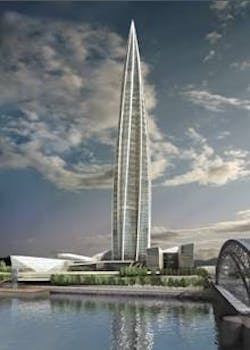Architect Touts Europe’s Tallest Tower
The design of the controversial new headquarters for oil giant Gazprom in St. Petersburg - which, at 396 meters tall, will become the tallest tower in Europe and a major new landmark in the Russian city - was recently a key focus of an international conference on the subject of ‘Tall Buildings' in London.
Director of RMJM's London office, Matt Cartwright, addressed the audience at the Tall Buildings conference, which was held earlier this month and was designed to debate the unique challenges posed by high rise buildings and the latest design and technical solutions. Cartwright, who was instrumental in the design of the Gazprom tower, focused on the cutting edge technologies and innovative sustainability solutions adopted in the design of the building.
Energy conservation has been at the forefront of the design process of the 396-meter twisting glass needle from its inception. In a country where temperatures dip to minus 30 degrees, RMJM, in partnership with leading environmental engineers Battle McCarthy, has designed an innovative energy solution where the need for heating is minimal in order to reduce its environmental impact.
The tower's environmental strategy is based on what is being described as a ‘fur coat' concept. The external envelope of the tower comprises of two double glazed glass skins with an atrium between the inner and outer walls. The atrium acts as a buffer zone providing both thermal insulation and natural ventilation at different times of the year.
The pentagram design of the tower maximises access to daylight and allows for spectacular views for the internal offices without losing heat due to exposed surface area in comparison to other structures.
In the earlier stages of the design process, results showed that 1200 different sized glass panels were needed, meaning a greater cost financially as well as a heavy environmental burden. Subsequently after much analysis, RMJM architects working with façade specialists Newtecnic found a more environmentally friendly solution by creating seven standard panels, allowing for repetition and a vastly smaller environmental impact.
The design allows for a generous number of social spaces and green ‘breakout' zones spread out along the floors. These enable office workers to access leisure areas without wasting valuable time and energy, in terms of vertical transportation, commuting to ground level.
Matt Cartwright, who revealed details of the tower's intelligent façade, vertical transportation, and specialised water, heating, and ventilation solutions at the conference, said:
"As a practice, we've been working on a multitude of sustainable buildings for the last 25 years such as the Zuckermann Institute at the University of East Anglia, the Information Commons building at the University of Sheffield, the Glaxo Welcome headquarters in Greenford, and the Scottish Parliament, to name a few, but most of these have been low rise. High rise buildings are often not thought of as environmentally sustainable and, through our work on the Okhta Tower, we've recognised the need to facilitate environmental efficiency in the commercial world.
"Most buildings take a limited approach to sustainability, picking a handful of issues to concentrate on which are often considered at the latter stages of the design or building process. With this project, we thought about sustainability issues right from the start and as such it has been totally integrated into the design, frame and structure.
"The Okhta tower is a complex, innovative building but we feel we have got the design right -integrating social, economic, and environmental aspects in harmony."
Gazprom's Okhta Centre was featured alongside other high profile buildings at the conference, organised by H&V News, including the Lighthouse in Dubai and The Pinnacle in London
